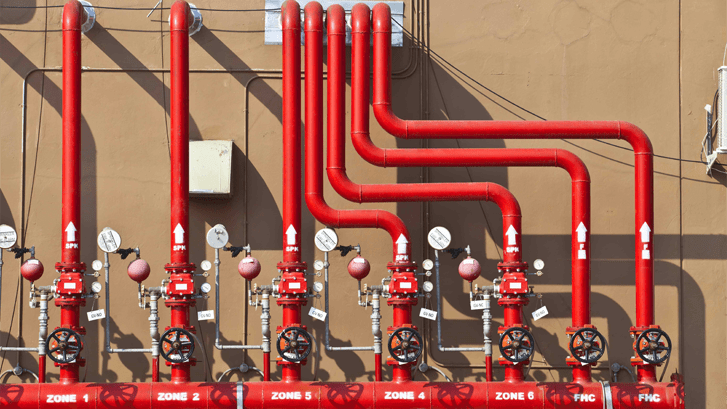

Fire Services include the installation, maintenance, monitoring, and retrofit of fire safety systems such as fire hydrant systems, fire sprinkler systems, fire alarms and detection systems and fire suppression systems.
Fire Services cater to the needs of various sectors including construction, pharmaceutical restaurants, retail, healthcare, assisted living, education, government, hospitality to name a few.
- Fire Detection Systems
- Fire Extinguishers
- Fire hydrants
- Smoke detectors
- Automated sprinkler systems
- Fire suppression system
Intelligent Addressable Fire Alarm Systems – These are often used in large and medium-sized projects and intelligent building an offer benefits in terms of speed of detection, identification of the location of fire and easier maintenance. Conventional Fire Alarm System – This system is designed to detect fires and send out a warning. It consists of smoke detectors at selected locations, to detect smoke at the earliest in the event of a fire.
Hybrid Fire Alarm System – This system combines the effectiveness of both the Intelligent Addressable and the Conventional Fire Alarm System.
Fire suppression systems are built to extinguish or prevent the spread of fire in a building.
Water Based Systems Fire Protection Systems – These systems include Sprinkler, Hydrant, Pre-action Systems, Kitchen Hood System, High and Medium Velocity Mist Systems and Tank Foam System to suit individual fire protection needs.
Gas Based Systems – In this system gas is used to extinguish the fire. It is automatic and within a minute of activation the fire gets extinguished. The various types of gas suppression systems are CO2, NAF SIII, FM 200 and Inergen.
Fire safety products encompass a wide range of equipment and tools designed to prevent, detect, and mitigate the risks associated with fires. Here are some common types of fire safety products:
Smoke Alarms: These devices detect smoke early on and emit a loud alarm to alert occupants of a building to evacuate.
Fire Extinguishers: Portable devices that discharge a jet of fire-suppressing agent (such as water, foam, dry chemical, or CO2) to extinguish small fires or suppress them until professional help arrives.
Fire Blankets: Fire-resistant blankets used to smother small fires or wrap around a person to extinguish flames on clothing.
Fire Sprinkler Systems: Automatic systems that release water or other extinguishing agents when a predetermined temperature is reached, helping to control or extinguish fires in buildings.
Fire Escape Ladders: Portable ladders designed for emergency escape from upper levels of buildings when stairways are impassable due to fire.
Emergency Lighting: Battery-operated or backup lighting systems that activate during power outages, aiding in safe evacuation during emergencies.
Fire Doors: Doors with fire-resistant materials and self-closing mechanisms to prevent fire and smoke from spreading between compartments in a building.
Fireproof Safes and Cabinets: Secure containers designed to protect important documents, valuables, or hazardous materials from fire damage.
Fire Retardant Treatments: Chemical treatments applied to textiles, woods, and other materials to reduce their flammability and slow down the spread of fire.
Fire Alarm Systems: Comprehensive systems that include smoke detectors, heat detectors, alarms, and monitoring capabilities to alert occupants and emergency responders to the presence of fire.
Fire Hydrants and Hose Reels: External water supply points equipped with hoses and reels for firefighters to connect and use during fire suppression operations.
Firefighting Gear and Personal Protective Equipment (PPE): Protective clothing, helmets, gloves, and boots worn by firefighters to safely enter and operate in hazardous fire environments.
Fire Barrier Systems: Fire-resistant barriers and seals installed within building structures to compartmentalize fire and smoke, preventing their spread.
Fire Suppression Systems: Specialized systems like foam systems, gas suppression systems (e.g., CO2, FM-200), and mist systems designed to extinguish fires or suppress them in specific environments or hazards.
Fireproof Sealants and Intumescent Products: Sealants and coatings applied to materials or building components to enhance their fire resistance and containment capabilities.
ANNUAL MAINTAINCE CONTRACTS
1. Fire Extinguishers
2. Fire Alarm Systems
3. Public Address Systems
4. Fire Hydrant Systems
5. Sprinkler Systems
Once installed, checking and maintenance of the fire system is very important. Since fire safety equipment is used only in the event of a fire, which is not often, it becomes very important to periodically check the equipment and products after installation. The maintenance of the fire products depend on the type of agreement that a customer does at the time of purchasing the equipment.
FIRE TRAINING/FIRE DRILLS – TRAINING RELATED TO FIRE AND SAFETY
Training include training related to evacuation, training related to the use of different fire safety products, training related to different types of fires and some basic tips related to fire fighting.


